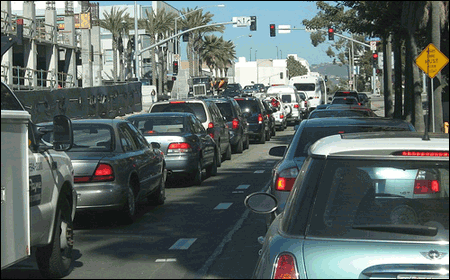Rising frustration over Santa Monica's congestion has led a group of citizens to qualify a ballot initiative for the November general election that would fight what they argue is the root of the problem: commercial development. The bill would cap the amount of commercial development allowed per year in the city at 75,000 square feet for the next 15 years. This is the equivalent of about two acres, or like building a new supermarket and a handful of fast food restaurants. This is a significant cut for a city that sees an average of 160,000 square feet of commercial development each year.
The proposal is on the Santa Monica ballot as Measure T (as in "Traffic"), but around town and throughout metropolitan L.A., the development cap is known as RIFT. The acronym is especially apt, as the proposal has caused a major divide amongst residents, officials and developers. It stands for Residents Initiative to Fight Traffic, and its authors assert that the city needs to more actively prevent traffic from getting even worse. Opponents argue that the name itself highlights the proposal's two main problems: one, it's a residents initiative, and two, it won't fight traffic.

The prospect of counteracting the city's gnarling traffic was enough to entice more than 10,000 residents' signatures, nearly double what was needed to qualify RIFT for the election. Authors of the bill say this overwhelming support underscores the need for action – action they're not seeing from local government.
"We don't believe that this commercial development serves the residents," says Ted Winterer, a co-author of RIFT and a candidate for Santa Monica City Council. "It begins to just become an engine for revenue growth." And more jobs. And more traffic.
It just makes my day when I hear Columbusites complain about traffic. "Why, I had to sit on that highway for fifteen minutes. It was insane!" While I understand city traffic always sucks, compared to the congestion in Chicago, Miami, Washington and LA, Columbus traffic is essentially non-existent. In fact, the highways here should be praised that when big events such as "Red, White and Boom" (which usually attracts 500,000 people) come, the events go off so smoothly. In my opinion, it's one of Columbus' finer attributes, its ability to orchestrate huge downtown events with stellar efficiency.








|